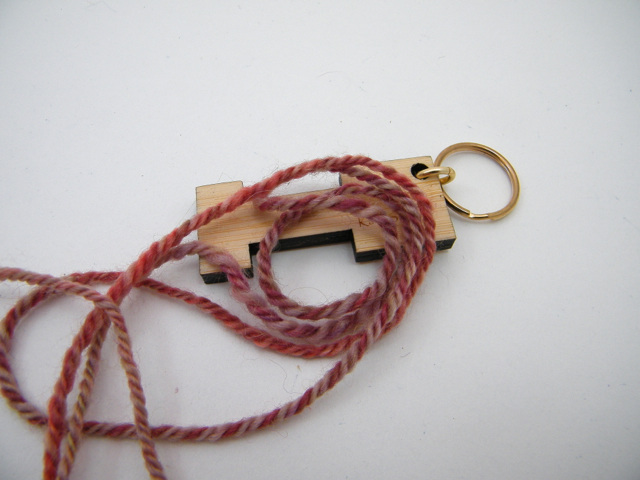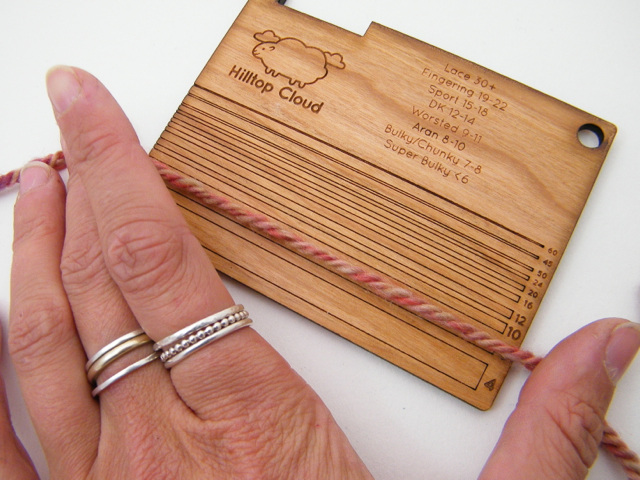|
This post works rather well with the article I wrote on measuring the length of your skein of yarn.After all, once you've finished spinning a skein of yarn the most useful thing you can know about it is how much you have, and how thick it is. Armed with that information you can go on to the advanced pattern search on Ravelry and find a pattern that will allow you to use every last metre of your yarn (all the options you need are on the left hand side). Measuring yardage is pretty straightforward. There's a bit of counting, and some very simple maths, but it's not really something that's open to debate. Yarn thickness however, is something of a dark art. As you get more experienced you do get better at eyeballing a piece of yarn and declaring "DK weight", but sometimes it's nice to check, and of course, eyeballing requires a bit of experience. I'm sometimes asked if there's not a chart a spinner can use to work out yarn thickness. There may well be, but I'd not trust it any further than I could throw it. Yarn thickness is effected by so much more than just the number of metres for any given weight. Hand spun always tends to be denser than commercial yarn, so most of the time a commercial yarn of around 400m/100g will be fingering weight (The term 4-ply might be more common in the UK, but isn't a great term to use as plys are the number of individual strands twisted together to make the yarn, a 4-ply can be any thickness). In handspun, if you have that much yardage per 100g you've often spun something thinner than fingering weight. Though not necessarily, it partly depends on the fibre used, and the style of spinning. Woollen yarn contains lots of air, so will have more yardage for a given weight at any thickness. Something like silk, where the fibres are tightly packed together will be much denser, so a lower yardage for a given weight at the same thickness. This is true no matter wether you're a spinner or not. Commercial yarns succumb to exactly the same effect. Socks That Rocks Lightweight is definitely a fingering weight yarn, but it's tightly spun, and tightly plyed structure only give it 250m/100g. In contrast Jamiesons & Smith Shetland Jumper Weight is a more woollen style yarn, lightly spun, lightly plyed, packed full of air. It has a whopping 456m/100g. Yarn thickness is measured using something called WPI, which stands for Wraps Per Inch. The idea is you wrap your yarn around a gap measuring 1 inch, and count how many strands you can fit in. It works pretty well for thin yarns, if you can manage to count how many strands you've got, not always easy when there's 50+ of them packed in that gap. For thicker yarns I've always found it an impossible technique to do accurately and consistently. I don't think I'm alone either, in an elderly Spin Off I once ready an article where many people were challenged to measure the wpi of a variety of yarns, their measurements differed wildly. By wrapping you often pull on the yarn, so it reduces in diameter, and then there's the "to-pack or not-to-pack" debate. This is a tradition wpi gauge, wrapped tightly, and with as many strands in there as I could fit. In total there are 16 of them squashed in there. Take a look at the same yarn, no longer under tension, and it's a very different beast. Even to look at, it doesn't look like a yarn that should measure 16wpi, and be a Sport Weight. Now admittedly the example above is an extreme one, but even if you relax your wrapping slightly, the act of winding the yarn in to a gap applies tension, and distorts the measurement. For years now I've instead being comparing my yarn to a line of a known thickness. The lines are based around divisions of 1 inch, so for example a line that measures yarn of 8wpi, will be 1/8th of an inch wide. I find it gives me far more consistent results. I used to have a little bit of printed card hung on my wheel, but now I can replace it with one of these. Laser cut, on ether cherry veneer, or acrylic plastic. It's got a wide set of lines on it for comparison purposes, and a reminder of how certain wpi measurements match to the names given to commercial yarns. To use you just overlay your yarn on top of the tool, and match it to the right thickness. Here's the same yarn I was measuring above. It just covers the 8wpi line, which compared to commercial yarns I've handled feels right, just on the border between a heavy Aran, and a skinny Chunky weight.
You can even attach it to your wheel and use it as a checking tool while you spin to help keep your singles a more consistent thickness. WPI Guages are available in the shop here. Comments are closed.
|
Archives
January 2024
Categories
All
|
Hilltop CloudHilltop Cloud- Spin Different
Beautiful fibre you'll love to work with. Established 2011 VAT Reg- 209 4066 19 Dugoed Bach, Mallwyd, Machynlleth,
Powys, SY20 9HR |




 RSS Feed
RSS Feed


